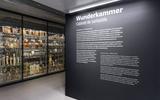Cabinet of Curiosities — The display collection
Millions of animals and plants are kept in scientific collections. These valuable archives of nature document biodiversity - the diversity of life - and enable basic research into the evolution, spread and variety of living organisms. Further work to deepen our knowledge of biodiversity is also invaluable for our society: for example, active substances and materials from nature that have not yet been discovered could be groundbreaking for future developments in medicine or agriculture.
Scientific collections are home to millions of specimens of animals and plants. They serve as indispensable archives of the natural world, documenting life in all its many forms – what we call ‘biodiversity’ – and allowing scientists to conduct essential research into the evolution, distribution and diversification of living beings. A deeper understanding of biodiversity is invaluable for our society: Natural materials and substances as of yet unknown species could be the basis for future groundbreaking innovations in medicine and agriculture.
Despite the fact that biodiversity is irreplaceable and vital to humanity’s survival, it is threatened, making research in this field more essential than ever. Of the estimated 10 million species in the world, only around 2.1 million have been documented, and everyday countless disappear forever, along with their habitats, such as rainforests and wild river landscapes.
With this exhibition, the museum is opening parts of its scientific collections to the public. A walk through our ‘Chamber of Wonders’ provides insight into our current collection activities, modern research methods and our priceless historical collections. All in all, the exhibition is an eye-opening overview of one of the most pressing issues of our time.
